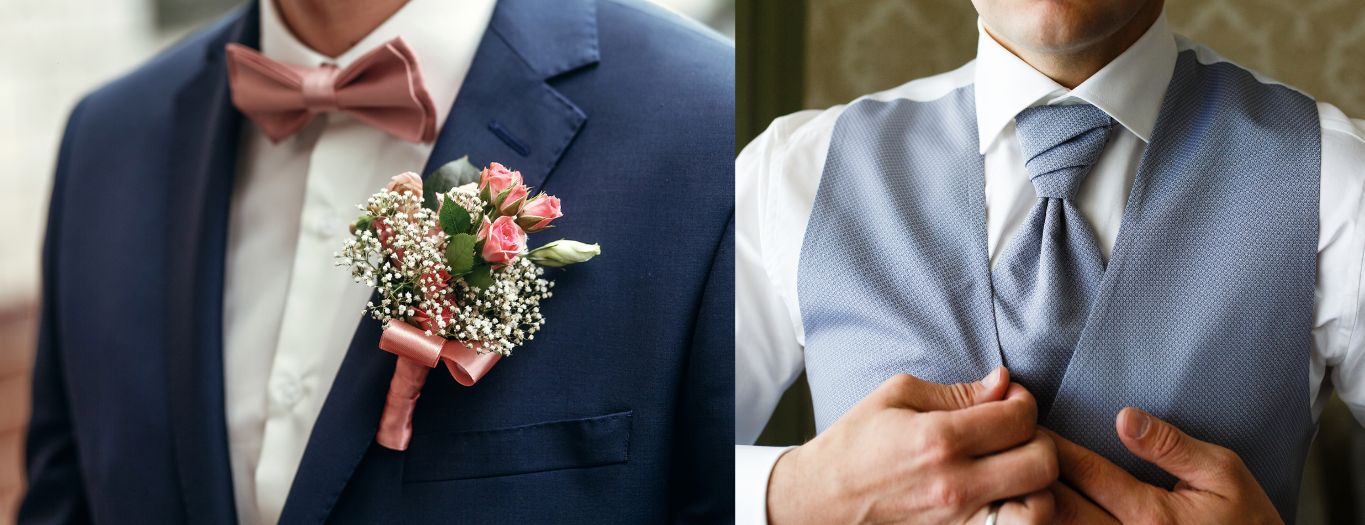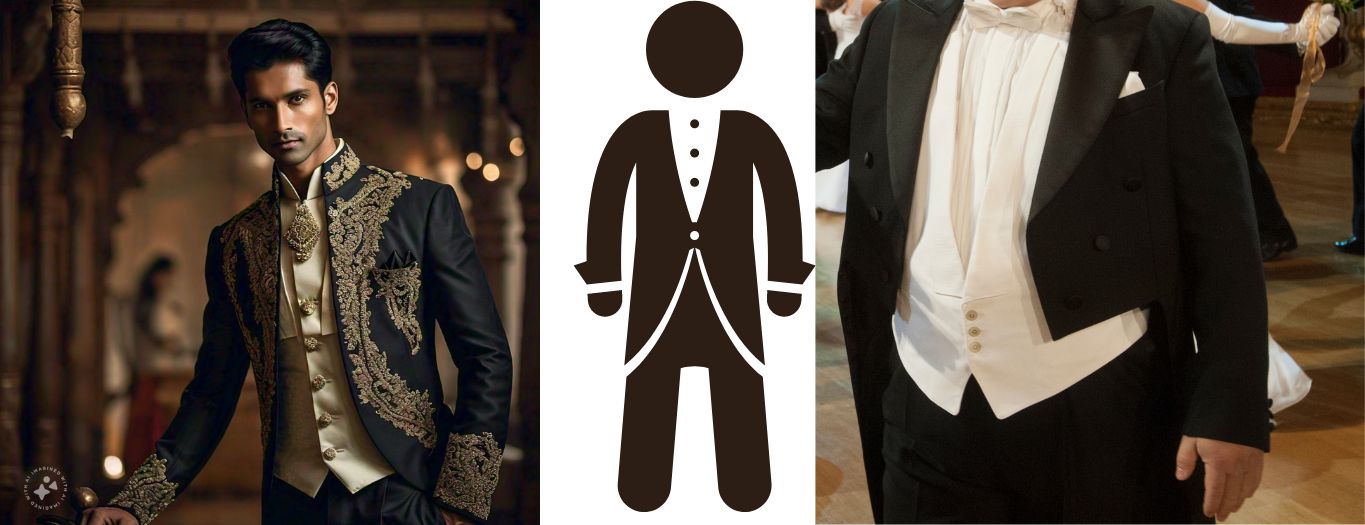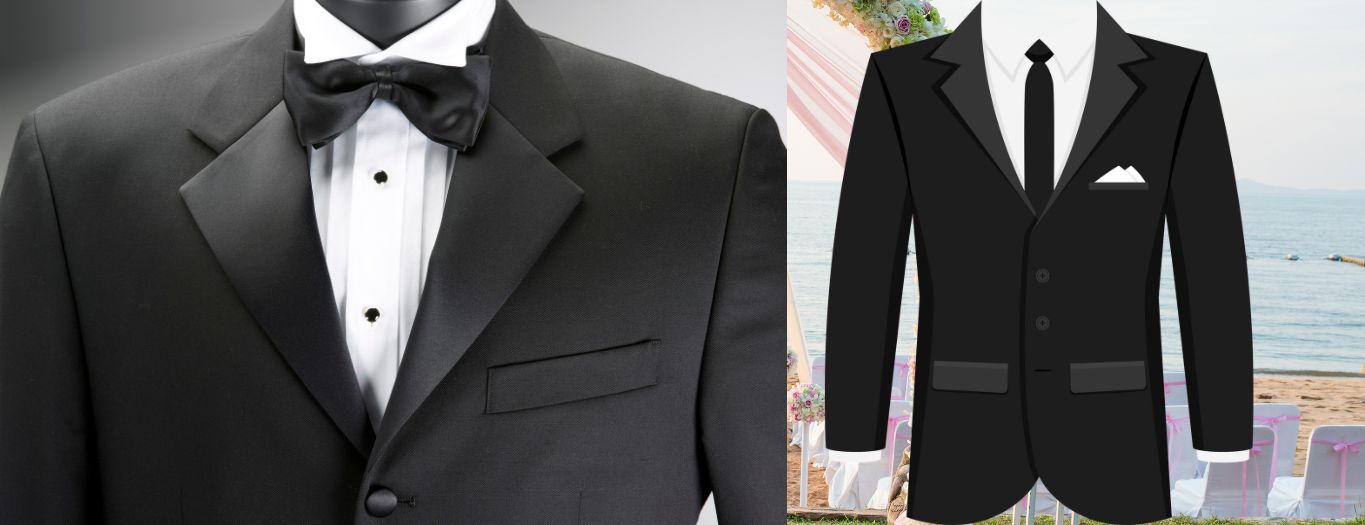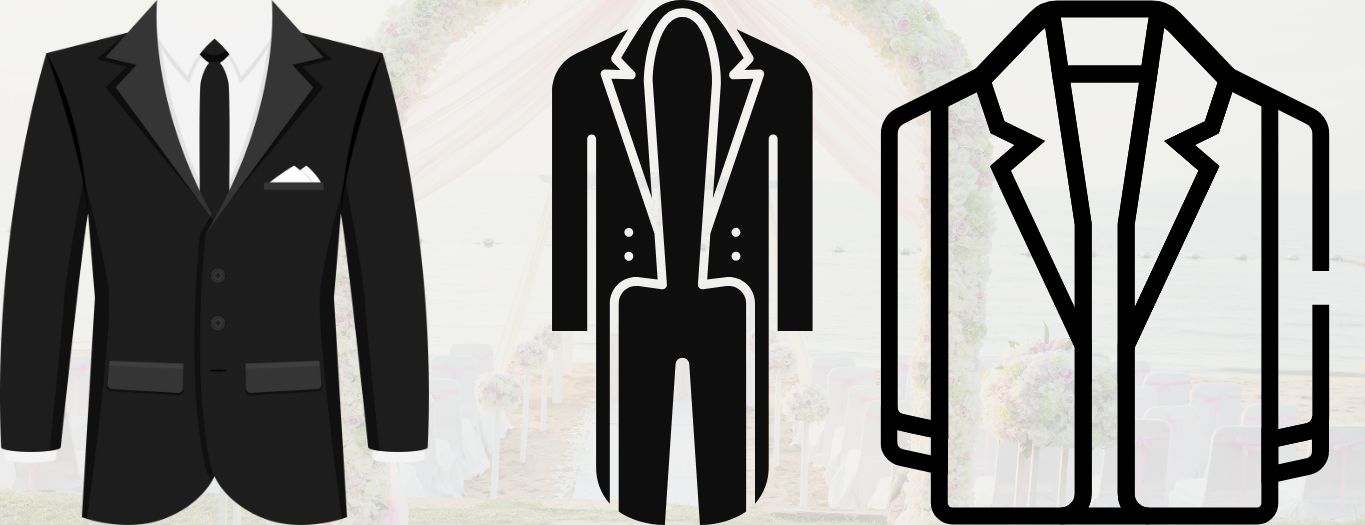We have specialised in weddings, helping numerous couples choose the perfect outfit for their special day. Our background in fashion design and vast experience have allowed us to gain a deep understanding of men’s etiquette and style, with a particular focus on evening wear.
We are here to share our knowledge and help you distinguish between a morning coat, a tailcoat and a tuxedo, ensuring the groom shines on his big day.
History and Origin
Formal menswear has evolved remarkably over the centuries, reflecting changes in etiquette, styles and cultural norms. From the traditional morning coat to the contemporary tuxedo, each suit tells a unique story, leaving its mark on masculine elegance for significant events. This section will explore the origins and evolution of the morning coat, tailcoat and tuxedo, pillars of distinction in formal menswear.
Morning Suit
The morning coat originated in the 19th century in England. It was initially a daytime outfit for the upper class and became a symbol of elegance and formality. Over time, it was widely adopted for weddings and formal daytime events, especially in Europe. Its unique design, with a jacket that lengthens at the back, makes it distinctive and traditionally elegant.

Ideal scenarios
The morning coat is perfect for daytime weddings and formally distinguished venues. The elegance of the morning coat lies in its characteristic jacket, longer at the back, which outlines a distinguished and elegant silhouette. It is perfect for ceremonies in majestic locations or charming estates, where the morning coat enhances the groom’s presence and adds a note of exclusivity and tradition.
What does the suit include?
A morning suit typically includes a long black or grey jacket with tails, striped trousers, a white shirt, a tie or a plastron and often a waistcoat. Accessories such as cufflinks and elegant shoes are essential to complete the outfit, reflecting the maximum exponent of masculine elegance.
What is the most elegant morning coat?
Although the morning suit is traditionally presented in shades of grey, the darker variants denote solemnity and distinction. The most elegant morning suit for the groom can be personalized in detail, such as the vest’s fabric or the tie’s texture, thus reflecting his personality and unique style.
Tailcoat
The tailcoat has its roots in the court attire of the late 18th and early 19th centuries. It was considered the most formal evening dress for high society events. Characterized by its jacket with long tails at the back and rigorous etiquette, the tailcoat has remained a symbol of the highest formality at evening and gala events.

Ideal scenarios
The tailcoat is the ultimate expression of formality and is reserved for evening events or high-end galas. This suit is distinguished by its short jacket at the front with long tails at the back, accompanied by specific trousers, a white shirt with a stiff front and a bow tie. The tailcoat is synonymous with great elegance and is ideal for large-scale events, where protocol and tradition are the protagonists.
What wears a tailcoat?
The complete tailcoat ensemble includes the characteristic black jacket with tails, matching trousers, a stiff-fronted shirt, a black bow tie, a cummerbund or waistcoat, and often patent leather shoes. Each element of the tailcoat is carefully designed to create an image of unparalleled distinction and elegance.
Tuxedo
The tuxedo, also known as the dinner jacket in some countries, emerged in the 19th century. It was popularized by the American and British elite as a less formal alternative to the tailcoat for evening events. The tuxedo symbolizes a balance between formality and modernity, being a popular choice for formal but less rigorous evening events than those requiring a tailcoat.

Ideal scenarios
The tuxedo is the preferred choice for formal evening events that do not reach the tailcoat’s level of etiquette but surpass the morning coat’s formality. It is a suit that combines perfectly with modern environments, galas, and evening ceremonies.
Its innate elegance makes it a sophisticated option for contemporary weddings or events with less rigorous etiquette.
What does a men’s tuxedo suit include?
The tuxedo consists of a jacket, usually black, with silk or satin lapels and a single button, accompanied by matching pants with a silk ribbon along the outer seam, a white shirt with a plain or pleated front, and a bow tie.
Often completed with a cummerbund or waistcoat, the simplicity and elegance of the tuxedo make it a favourite for those seeking a balance between formality and modern style.
What are the different Types of Wedding Suits for Groom?
Different types of suits vary in style, cut, and occasion. From the traditional suit for business or less formal events, the morning coat for daytime and ceremonial events, the tailcoat for the most formal occasions, to the tuxedo for elegant evening events. Each has characteristics that make them unique and suitable for different events and personal preferences.
How many types of men’s suits are there?
There are numerous men’s suits, each suited to different occasions and personal styles. Some of the main ones are the traditional suit, the morning coat, the tailcoat, the tuxedo, and variants such as the three-piece suit, among others. The choice depends on the event’s formality, time of day, and personal taste.
What is the difference between a tuxedo and a morning coat?
The morning coat is characterised by its jacket with tails and is mainly used for daytime weddings or formal daytime events. At the same time, the tuxedo is for evening events and is distinguished by its jacket with silk lapels and absence of tails. The morning coat promotes a traditional and highly formal image, while the tuxedo offers a more modern and versatile vision of elegance.
What is the difference between a suit and a tuxedo?
The traditional suit is less formal than the tuxedo and is used in more everyday contexts or less formal events. While the suit consists of a jacket and trousers of the same fabric and colour, usually without distinctive details, the tuxedo raises the level of formality with its silk lapels, the side tape on the trousers and the bow tie, marking a clear difference in occasion and elegance.
What is the difference between a tuxedo and a tailcoat?
The tuxedo is less formal than the tailcoat and is worn at evening events that do not require the highest level of formality. The tailcoat, with its tailed jacket and white bow tie, is chosen for grand gala events. The tuxedo, with its plain jacket and black bow tie, offers a sophisticated but slightly more relaxed image.
Fit and Size Tips
Morning suit
The morning coat should be fitted so the jacket hangs gracefully without pulling or wrinkling. The tails should reach just to the bottom of the knees. The trousers should be high-waisted and fit comfortably, with perfectly aligned vertical stripes.
Tails
The tailcoat requires an impeccable fit. The jacket should cover the waist in front, and the tails should be elegantly parted in the back. The shirt should fit well around the neck and torso, and the cummerbund or waistcoat should be tight but comfortable, without wrinkles.
Tuxedo
The tuxedo should fit so the jacket closes without pulling, and the shoulders should perfectly align with the wearer’s shoulders. Pants should fit comfortably at the waist and be adequate to cover the top of the shoe.
Recommended Accessories
Morning suit
The morning coat is best complemented with black leather Oxford shoes, a silk tie or plastron, elegant cufflinks and a top hat for a traditional touch.
Tails
For the tailcoat, black patent leather shoes, a white bow tie, discreet cufflinks and, in some cases, a white silk scarf and white gloves are recommended for the most formal events.
Tuxedo
Black patent or polished leather shoes, a black silk bow tie, elegant cufflinks and a discreet dress watch ideally accompany the tuxedo.
Understanding the differences between a morning coat, tailcoat, and tuxedo is essential to ensuring the groom looks his best on the most important day of his life. Each of these suits has its place and time, and choosing correctly between them will reflect not only the groom’s style but also respect and understanding of the event’s etiquette.
From our experience, we always recommend considering the type of event, the time, and the groom’s personal preferences and comfort when choosing between these elegant options. With the information and advice provided, we hope that every groom will find the perfect suit to shine on his big day.
